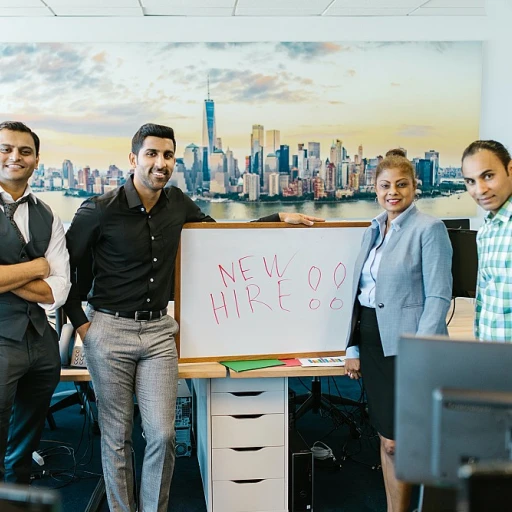Understanding the Team Development Phases
Recognizing the Critical Stages in Team Development
Understanding the phases of team development is fundamental for fostering effective collaboration among team members. The process, often explained through the Tuckman model, reveals a sequence of stages that groups typically experience as they evolve and grow. These stages are known as forming, storming, norming, and performing, each representing a unique phase in the team's development. Despite being a well-established methodology, developed by Bruce Tuckman, the model remains pivotal in guiding leaders toward creating cohesive and high-performing teams. The journey begins with the forming stage, where team members are introduced, and their roles are defined. This initial phase can often be characterized by excitement and apprehension as individuals strive to understand their tasks, the context of the project, and the goals set by leadership. This phase is pivotal because it lays the foundation for interpersonal interactions and group dynamics. The storming stage follows, where conflicts and competition may arise. During this time, team members challenge each other and leadership, highlighting different perspectives and potential misalignments. This stage can be particularly difficult, yet it provides an opportunity for growth and development. Leaders who effectively navigate these challenges set the stage for the norming phase, where the focus shifts to building trust and cohesion. As the team enters the norming stage, members begin to establish stronger relationships, creating a more cohesive unit. Clear communication and mutual respect become prevalent, allowing individuals to collaborate more effectively. The group starts to see the advantages of working together and begins to consolidate its approach to achieving the set objectives. Ultimately, teams strive to reach the performing stage, where they operate at their highest potential. At this point, group dynamics have stabilized, and members work seamlessly towards common goals. Leaders play a crucial role in maintaining the momentum during this phase, ensuring the team continues to perform at its best. Recognizing and navigating these developmental stages is vital for teams committed to achieving long-term success. As each stage has its own challenges and opportunities, understanding these nuances can significantly enhance workplace dynamics. To further explore strategies for building effective team cohesion, consider these insights on effective team bonding.The Storming Phase: Challenges and Opportunities
Understanding the Dynamics of the Storming Stage
The storming stage in team development is often characterized by turbulence and conflict. This phase is a critical part of the developmental sequence described by Bruce Tuckman. During this stage, team members may experience disagreements and power struggles as they work towards defining their roles and responsibilities. This is a natural part of the group development process, but it can be challenging for both the team and its leaders.
Challenges Faced by Teams in the Storming Phase
In the storming stage, teams often face several hurdles:
- Conflicting Goals: Team members may have different priorities and objectives, leading to friction.
- Leadership Struggles: The absence of clear leadership can cause confusion and competition among team members.
- Communication Breakdowns: Misunderstandings and lack of communication can exacerbate tensions.
- Resistance to Change: Some team members might resist the changes necessary for moving forward.
Opportunities for Growth and Development
Despite the challenges, the storming stage offers valuable opportunities for growth. It is during this phase that teams can develop stronger communication skills and a deeper understanding of each member's strengths and weaknesses. Leaders can play a pivotal role by guiding the team through conflicts and fostering an environment of open dialogue and trust.
By navigating the storming phase effectively, teams can lay a solid foundation for the subsequent stages of norming and performing. This progression is essential for achieving high performance and enhancing overall employee engagement. Understanding the intricacies of this stage is crucial for leaders aiming to build cohesive and resilient teams.
Achieving High Performance: The Performing Phase
Reaching Peak Productivity
The performing phase is widely regarded as the period where productivity reaches its zenith. At this stage, teams have surmounted the storming hurdles and evolved into efficient, cohesive units. Each member is aware of their role, the goals are clear, and the workflow is smooth, with minimal friction. When a team transitions into the performing stage, the real potential of collective effort emerges. This phase is characterized by a palpable sense of unity, where members capitalize on each other's strengths, leading to enhanced problem-solving and innovative solutions. Teams are now adept at self-management, standing evidence of the model put forward by Tuckman. This developmental sequence is a testament to the team’s maturity and resilience through the past challenges associated with the storming phase. Groups in the performing stage demonstrate flexibility and adaptability, crucial for handling unexpected challenges that may arise during a project. Leadership plays a pivotal role here, offering guidance when necessary and facilitating an environment where members feel empowered to take initiative. Sustaining this phase requires a consistent commitment to team development and a keen understanding of group dynamics. Moreover, maintaining high-performance levels links to the broader context of employee engagement. Engaged team members, who are genuinely invested in their work, lead to productive, vibrant teams. Encouraging ongoing enhancement in employee engagement within the performing phase can be achieved through systematic support and recognition, ensuring the team remains on track and highly motivated.The Norming Phase: Building Cohesion and Trust
Establishing Unity and Confidence in the Team
The norming phase of team development plays a crucial role in shaping a cohesive and trustful environment. As groups transition from the challenging storming stage, team members begin to embrace a smoother and more united approach towards their work and shared objectives.Fostering Relationships and Collaboration
During this stage, team members have the opportunity to strengthen their relationships. By fostering open communication and respecting diverse viewpoints, teams can effectively bridge any gaps that may have emerged during earlier stages like forming and storming. Encouraging collaboration strengthens the connections among members, leading to a stronger collective identity within the group.Aligning Goals and Expectations
An essential component of the norming stage is aligning the team's goals and expectations. It is vital that all team members share a clear understanding of their individual and collective objectives. This alignment helps streamline efforts, directing them towards achieving high performance in the performing stage. By setting clear goals, team members can focus their energies more effectively, thereby enhancing the overall efficiency and productivity of the group.Emphasizing Supportive Leadership
The role of leadership is pivotal in nurturing a supportive atmosphere during the norming phase. By promoting a culture of trust and offering guidance, leaders can facilitate smoother transitions through the stages of development. A strong leadership presence provides the reassurance team members need to adapt and thrive. The journey through team dynamics can be intricate, with each phase presenting its own set of challenges and opportunities. However, mastering the norming stage can profoundly impact the development of high-functioning teams, setting the foundation for a performing phase characterized by exceptional unity and productivity.Strategies for Navigating Between Phases
Effective Strategies for Transitioning Team Phases
The journey through the tuckman stages of team development can often involve navigating a plethora of challenges and objectives. As a team progresses from the initial forming stage through to the performing stage, it's crucial for leaders to implement strategic measures that facilitate smooth transitions between each phase.
One of the most significant transitions occurs from the storming stage, where conflicts and differences can arise, to the norming stage, where teams begin to develop cohesion and trust. During the storming phase, leaders can play a critical role by fostering open communication and addressing conflicts promptly to prevent stagnation and encourage progress toward norming.
The following strategies can enhance the effectiveness of this transition:
- Facilitate Open Dialogue: Encourage team members to voice their concerns and ideas. An environment where ideas and concerns are heard can significantly ease tensions and promote resolution.
- Define Clear Goals: Establishing common objectives helps align team efforts and focus, reducing resistance and promoting solidarity as the group moves from storming to norming.
- Empower Team Leadership: Support the developmental sequence by allowing leaders to guide the transition smoothly. Confidence in leadership often encourages a collective drive towards the next phase.
- Promote Trust-Building Activities: Enhance the group dynamic through team-building exercises that strengthen inter-personal relationships, laying the groundwork for a performing team.
Once a team reaches the norming stage, it naturally begins to build cohesion which is essential for achieving the high performance seen in the performing phase. Leaders should continuously monitor team dynamics and adjust their strategies to maintain the delicate balance required through each of these stages.
These strategies not only facilitate smoother transitions but also contribute to stronger employee engagement, which is vital for the team's growth and productivity. As teams evolve, they deliver more effectively on project goals, ultimately feeding into broader organizational success.
The Impact of Team Development on Employee Engagement
Team Development's Influence on Engagement
The interaction of different phases in team development has a significant bearing on employee engagement within any group or organization. As teams transition through the stages of forming, storming, norming, and performing, the impact of each phase is tangible on how engaged team members feel in their work.In the storming stage, where challenges and disagreements may arise, the pressure of navigating conflicts can either drive disengagement or, if well-managed, catalyze stronger bonds and commitment. Leaders who adeptly address conflicts during this stage can transform potential downturns in morale into opportunities for boosting engagement by fostering open communication and understanding among team members.
When a group transitions smoothly into the performing stage, the emphasis on high performance naturally engenders a sense of purpose and belonging. Team members who see their efforts culminating in success often experience a boost in motivation, aligning individual goals with team objectives. This synergy is crucial for sustaining employee engagement, as individuals feel more connected to the team's achievements and proud of their contributions.
The norming phase presents an opportunity for strengthening relational ties and building trust within the team. During this stage, leaders should focus on nurturing a collaborative environment where team members support each other and align around common goals. The enhanced cooperation and mutual respect developed in the norming stage are pivotal in maintaining active engagement.
Moreover, leaders should remain vigilant and responsive to shifts between the stages of group development. By deploying targeted strategies to navigate these transitions—such as facilitating workshops, providing constructive feedback, and encouraging team bonding—leaders can maintain high levels of engagement.
Overall, understanding and managing the dynamics of team development phases not only helps in achieving project goals but also plays an essential role in fostering long-term employee engagement.











